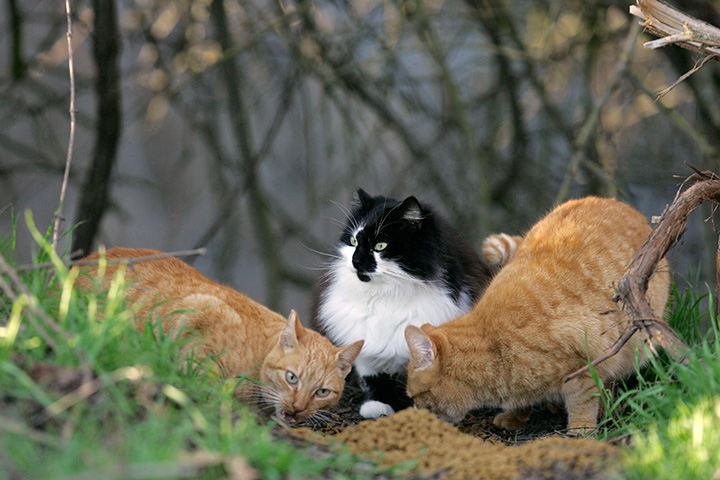Pierre Filiatreault looked out his office window at Halifax’s naval base 12 years ago and saw two tiny kittens playing together in a narrow alleyway.

The kittens – one with fluffy orange and white fur and one all black – appeared malnourished and without a mother, so Filiatreault began feeding them.
He fashioned a small makeshift shelter out of Plexiglas and other scrap materials. The pair could often be seen cuddled together inside the enclosure, resting their heads on each other’s back paws, their bellies touching.
Eventually the naval officer took them to the SPCA, where they were adopted. But the two kittens were not the only felines roaming the base in search of food and shelter.
READ MORE: DNA shows cats and humans have long historic relationship
Feral cats are a common sight at HMC Dockyard – home to Canada’s East Coast navy, including frigates and the submarine HMCS Windsor.
Filiatreault retired in 2009 as a petty officer first class after serving 31 years in the navy, but he still visits the base near downtown Halifax every day to feed the roughly 20 stray cats that call it home.
“The cats are part of my life now. As you feed animals, you get attached to them,” said Filiatreault in front of a cat shelter dubbed “Saraphyna” that’s nestled into a ledge that overlooks the Halifax harbour.
“It’s not work anymore. They’re part of the family.”
Filiatreault, also known as the Catman, has special permission from the Defence Department to maintain several cat shelters at the yard and enter the base each day to feed what have become known locally as the “dockyard cats.”
In 2005 he started to trap, neuter and return the cats to help control the population. Kittens have not been born at the base in roughly nine years, and the oldest cat is now around 14. Feral cats usually only live two or three years.
READ MORE: Dublin vet hiring a cat cuddler with a ‘cattitude’
Each has a name – like Binoo and Black Chin – and will come to Filiatreault when called. They respond to three languages, given Filiatreault is French and his wife Paola – who helps with the feeding – is Italian, and both speak English.
There are two cat colonies at the dockyard, referred to as the “city” and “country” cats.
On the south end, a contingent of black and white cats roam a concrete jungle-of-sorts amidst the bustle of Canada’s Atlantic naval fleet.
They can be seen scampering up wooden planks Filiatreault has attached to the side of buildings, allowing them to navigate from an upper roadway to an oceanside docking and loading area.

The four-legged furballs sometimes trot along the wharf alongside uniformed officers and snooze in the shade under row boats stored on racks.
The city cats eat inside the “Catty Shack” shelter – a white barn-style shed with a cat door that sits in the shadow of the Macdonald Bridge and is nestled among shipping containers and the base’s post office. Around back is one of Filiatreault’s first shelters he built in 2005 from an old fridge.
The Catty Shack is heated with light bulbs, keeping it at about 10 C, and inside are cubbies equipped with cat beds and an endless supply of dry food.
It’s the first stop on the daily run – when Filiatreault or his wife check on their feline friends, give them deworming and anti-flea medications and bring more desirable edibles.
“They love treats. My wife spoils them – chicken, ground beef, steak or ham, depending on the season,” said Filiatreault, scooping out wet cat food onto a dish and mixing it with vitamins.
“They’re friendly, but they are feral cats so you cannot touch them.”
Meanwhile, the north end cats are happy trotting through tall grass or napping inside an old boat – dubbed “the Ark” – which sits in a small green space and is covered by wood framing and Plexiglas for added protection from the elements. Cina, who has long orange fur, can often be found sleeping inside.
Placid, a short-haired white cat that has undergone three knee surgeries, is the local boss. He often perches on a retaining wall that overlooks the Saraphyna Shelter and Ark below.
Multi-coloured Cleo has also proven to be somewhat of a chieftain of her clan. She recently defended their territory when another cat – Benny from the city colony – wandered in.
“She was quite adamant that they did not want him there,” he said. “It’s like street gangs. It works the same way with feral cats. They all have their own section of the dockyard.”
Navy officers will sometimes come visit the country colony on their lunch break, bringing treats.
READ MORE: Cat yoga helping out Saskatoon SPCA
There are only a couple dozen cats now living at the dockyard, but that number was once closer to 100 in the 1990s, before Filiatreault took an interest.
He raises money to keep the dockyard program running under Pierre’s Alley Cat Society, which is in its 10th year. Cats can be sponsored on a monthly or yearly basis, which pays for their food and any vet visits.
Filiatreault said the Defence Department has always been supportive of his initiative and has even provided funding and manpower when the shelters were first constructed. There was a ribbon-cutting ceremony for the opening of the Catty Shack.
He said he will continue the dockyard program until its natural conclusion – when the remaining residents live out their lives.
“All animals deserve a chance to live,” said Filiatreault. “It could be another two years or it could be five years, but I’m in it for the long haul.”



Comments